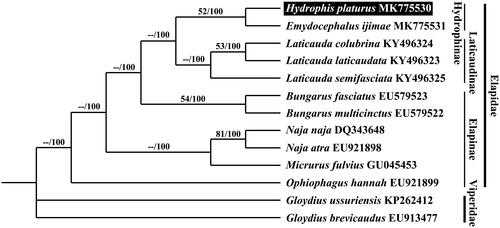Abstract
In this study, we provide the first report of the complete mitochondrial genomic sequencing of a yellow-bellied sea snake (Hydrophis platurus) that has the broadest distribution range of all Squamata species. The mitogenome length was 18,101 bp and consisted of 13 protein-coding genes, 2 rRNA genes, 22 tRNA genes, and 3 non-coding regions. The sequence presented could be very useful for further phylogenetic and evolutionary studies.
A total of three true sea snakes in genus Hydrophis have been reported in the Korean sea. However, there are only a few papers reporting studies in Korea on true sea snakes (Hydrophinae) due to the paucity of information on this large group of representative marine Elapidae (Reptile database, 2019). Yellow-bellied sea snakes (Hydrophis platrus) have the largest and broadest distribution range of all species in the order Squamata (Brischoux et al. Citation2016). Although their distribution is broad, only the complete mitochondrial DNA of three sea kraits (Laticaudinae) and one sea snake are known and there are no published studies on H. platurus (Kim et al. Citation2018; Yi et al. Citation2019). The H. platurus specimen was collected from Seongsan-eup, Seogwipo-si, Jeju-do, Republic of Korea (33°11′N and 127°33′E) on 26 June 2017. The specimen was preserved in 70% ethanol and kept at the National Marine Biodiversity Institute of Korea (Voucher No. MABIK SE002822).
We extracted whole genomic DNA from the muscle tissue of the specimen using the phenol-chloroform isoamyl alcohol (PCI) method using DNA extraction solution obtained from Asahida et al. (Citation1996) and proteinase K (Bioneer, Daejeon, South Korea). We designed 16 primer sets to amplify the segments by long-range PCR. Sequencing was performed at Macrogen Inc. (Seoul, South Korea). To assemble and annotate the mitochondrial DNA sequence, we used Geneious 9.0.4 (Biomatters Ltd, Auckland, New Zealand), tRNA Scan-SE1.21 software (http://lowelab.ucsc.edu/tRNAScan-SE/) (Lowe and Eddy Citation1997), and the Dual Organellar GenoMe Annotator (DOGMA) (Wyman et al. Citation2004). The phylogenetic tree for H. platurus and other related elapid snakes was constructed with PAUP* v4.0b10 (Swofford Citation2003) using 13 protein-coding genes (PCGs) obtained in this study and GenBank (). We applied the Bayesian inference and maximum likelihood methods to construct the tree with 1000 bootstrap replicates.
Figure 1. Bayesian inference (BI) tree based on 13 mitochondrial protein-coding genes of Hydrophis platurus with 10 other elapid snakes. Two species of Viperidae were used as the outgroup. The accession numbers of the mitogenomes obtained from GenBank are indicated after the scientific name of each species. The analyzed values (ML bootstrap value/Bayesian posterior probabilities) are noted on each branch.

The total length of the H. platurus mitochondrial genome was 18,101 bp (GenBank Accession No. MK775530), with base compositions of 33.8% A, 27.6% T, 12.4% G, and 26.2% C, indicating an A-T rich (61.4%) feature. The mitogenome contained 13 PCGs, 2 rRNA genes (12S and 16S rRNA), 22 tRNA genes, and 3 non-coding regions of two control region and an L-strand replication origin (OL). The arrangement pattern and transcribing directions of the mitogenome were identical to those of other elapid snakes (Laticauda semifasciata and Emydocephalus ijimae) previously reported (Kim et al. Citation2018; Yi et al. Citation2019). The phylogenetic tree for H. platurus and other related elapid snakes showed that genus Hydrophis and genus Emydocephalus formed sister groups () and subfamily Hydrophinae and Laticaudinae showed close relationships. This result is similar to those in a previous result by Lee et al. (Citation2016) that reported the phylogenetic relationships of elapid snakes based on 12S, 16S, ND4, cytochrome b, nuclear C-mos, RAG-1, and RAG-2 sequences.
Disclosure statement
No potential conflict of interest was reported by the authors.
Additional information
Funding
References
- Asahida T, Kobayashi T, Saitoh K, Nakayama I. 1996. Tissue preservation and total DNA extraction from fish stored at ambient temperature using buffers containing high concentration of urea. Fisheries Sci. 62(5):727–730.
- Brischoux F, Cotté C, Lillywhite HB, Bailleul F, Lalire M, Gaspar P. 2016. Oceanic circulation models help to predict global biogeography of pelagic yellow-bellied sea snake. Biol Lett. 12(8):20160436.
- Kim IH, Park J, Suk HY, Bae HG, Min MS, Tsai TS, Park D. 2018. Phylogenetic relationships of three representative sea krait species (Genus Laticauda; elapidae; serpentes) based on 13 mitochondrial genes. Mitochondrial DNA Part A. 29(5):772–777.
- Lee MS, Sanders KL, King B, Palci A. 2016. Diversification rates and phenotypic evolution in venomous snakes (Elapidae). R Soc Open Sci. 3(1):150277.
- Lowe TM, Eddy SR. 1997. tRNAscan-SE: a program for improved detection of transfer RNA genes in genomic sequence. Nucleic Acids Res. 25(5):955–964.
- Swofford DL. 2003. PAUP*: phylogenetic analysis using parsimony, Version 4.0 b10. https://www.researchgate.net/publication/271205405_PAUP_Phylogenetic_Analysis_Using_Parsimony_and_Other_Methods_Version_40b10
- Wyman SK, Jansen RK, Boore JL. 2004. Automatic annotation of organellar genomes with DOGMA. Bioinformatics. 20(17):3252–3255.
- Yi CH, Park J, Sasai T, Kim HS, Kim JG, Kim MS, Cho IY, Kim IH. 2019. Complete mitochondrial genome of the Ijima’s Sea Snake (Emydocephalus ijimae) (Squamata, Elapidae). Mitochondrial DNA Part B. 4(2):2658–2659.
